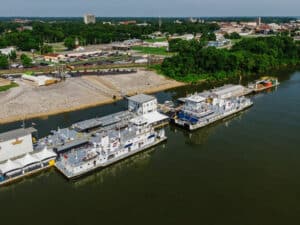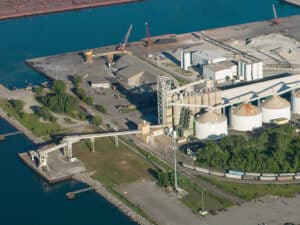
Q&A: Jen Armstrong, director government relations at Waterways Council Inc.
Written by Heather Ervin
Jen Armstrong, Waterways Council Inc.
Last month, The Waterways Council Inc. (WCI) appointed Jen Armstrong as director, government relations, joining Dustin Davidson in this role. Marine Log sat down with Armstrong to discuss her new role at WCI and more.
Marine Log (ML): First off, congratulations on your new role! How do you plan to tackle this role within Waterways Council Inc. as we continue into 2023 and beyond?
Jen Armstrong (JA): Thank you. I am very excited to be here. One of the WCI’s greatest strengths is effectively communicating accurate information to the right decision makers at the right time. I experienced this firsthand in my previous position with the U.S. Senate Appropriations Committee. In my new role, I plan to use the perspectives I gained from that experience and my experience with the Corps of Engineers to add value to WCI’s advocacy efforts.
While the recent injection of $2.5 billion in funding from the Infrastructure Investment and Jobs Act (IIJA) was a major win, turning those dollars into completed projects that produce economic benefits is the true measure of success. When operational, the inland projects funded by IIJA will provide $925 million in annual economic benefits to the nation. As we continue into 2023 and beyond, my role will be ensuring these projects are executed efficiently and consistent with the priorities of the industry users.
ML: You have quite the resume, with your most recent position being director of navigation policy and legislation for the American Association of Port Authorities. Can you tell us more about your past career leading up to your current role with Waterways Council Inc?
JA: My career started as a military project manager with the Corps of Engineers in Norfolk, Va. After several years of managing military construction projects on installations throughout Virginia, I moved to Louisiana to work on the Hurricane Protection System in New Orleans that was constructed by the Corps in the wake of Hurricane Katrina. This was my first exposure to the Corps’ Civil Works mission and ultimately what led me on the path to the U.S. Senate, and now WCI.
The Corps offers many opportunities to grow professionally, and I was very fortunate to be able to deploy and seek out developmental assignments that gave me a well-rounded understanding of the Corps’ Civil Works program. One such opportunity was working on a temporary assignment with the U.S. Senate where I was able to use my construction and project management experience with the Corps to communicate complex issues and policies to the appropriate Senate committees.
I was asked to join the Senate permanently as a professional staff member and served on the Appropriations Committee for the successful passage of seven Energy and Water Development funding bills. When I made the difficult decision to leave Congress, it was very important to me that I continued to be involved with our nation’s water resources. I’m happy to be the newest member of the Waterways Council team and it will be a natural fit with my previous roles.
ML: What would you say are your (and WCI’s) top priorities at this time and how can the greater waterways industry contribute to these goals?
JA: Securing appropriations for the full amount supportable by annual diesel fuel tax receipts deposited into the Inland Waterways Trust Fund (IWTF) and any additional funding needed from the balance of the IWTF continues to be a top priority. To accomplish this, working with the Corps to obtain an accurate balance available in the IWTF along with the latest construction capabilities for that fiscal year is very important.
Failing to provide sufficient appropriations will delay project completion, increase costs and delay realization of substantial benefits to our nation’s economy. Unfortunately, past and present administrations have not prioritized maximizing full use of the IWTF in their annual budget requests to Congress. Until the current fees being collected are prioritized for spending, WCI will continue to oppose any additional tolling, lockage fees, or other harmful charges for users of the inland waterways system. Users already successfully advocated in support of raising that tax by 45% in 2014 to its current level of 29-cents per gallon, which is the highest federal fuel tax currently being paid by a surface transportation mode.
Industry can contribute to these goals in a variety of ways. Of course, becoming a member of Waterways Council is an important first step! Our members participating in Congressional outreach is a key part of our success. We host our Capitol Hill fly-in during the first quarter of the year, to leverage the Appropriations process, which gets underway at that time. And our members can advocate Congress all year long with our grassroots advocacy tools. Social media can also be effective. Thanking a legislator in a public platform can make a difference in building a relationship with your Senators and House Representative.
ML: Finally, what is your favorite thing about working with and advocating for the inland waterways?
JA: I think most people who are unfamiliar with the inland waterways system are shocked to learn just how important and unique it really is. My favorite part is the “Aha!” moment they have when they realize how much of their daily life is impacted by goods transported on the inland system. Barges on the inland system are largely out of sight.
It is easier for people to connect those dots with other modes of transportation because they see trucks on the road or the rail cars that make them wait at crossings. It is always cool to raise an eyebrow explaining that one full barge load of wheat is more than enough to provide a one-pound loaf of bread for every person living in Oklahoma in 2019 or that one 15-barge tow is the equivalent of 1,050 large tractor trailers on the road. There’s something for everyone.

![Tom Frazier aground and listing to starboard on Feb. 11, 2024. [Photo: U.S. Coast Guard]](https://www.marinelog.com/wp-content/uploads/2025/06/Towboataground-300x225.jpg)


